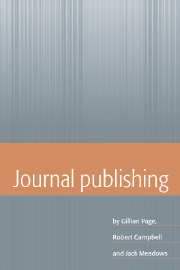Book contents
- Frontmatter
- Contents
- List of figures
- List of tables
- Preface
- 1 Introduction to journals
- 2 Editing
- 3 Production
- 4 Marketing
- 5 Subscription management and distribution
- 6 Non-subscription revenue
- 7 Legal and ethical aspects
- 8 Financial aspects
- 9 Bibliographic aspects
- 10 Managing a list of journals
- 11 Electronic publishing
- Appendix 1 Getting tenders for journals
- Appendix 2 Publishers' and editors' associations
- Glossary
- Bibliography
- Index
11 - Electronic publishing
Published online by Cambridge University Press: 23 October 2009
- Frontmatter
- Contents
- List of figures
- List of tables
- Preface
- 1 Introduction to journals
- 2 Editing
- 3 Production
- 4 Marketing
- 5 Subscription management and distribution
- 6 Non-subscription revenue
- 7 Legal and ethical aspects
- 8 Financial aspects
- 9 Bibliographic aspects
- 10 Managing a list of journals
- 11 Electronic publishing
- Appendix 1 Getting tenders for journals
- Appendix 2 Publishers' and editors' associations
- Glossary
- Bibliography
- Index
Summary
Introduction
The term ‘electronic publishing’ has more than one connotation. On the one hand, it can describe a situation where the entire flow of information from author to reader (via whatever intermediaries are necessary) is in machine-readable form. On the other, it has been used to describe information transfer in machine-readable form up to the final stage, when the reader is supplied with hard-copy. (Indeed, it has also been applied to the conversion of printed material into machine-readable form.) In essence, the various usages tend to blur into each other. For example, many readers prefer to read lengthy pieces of text from printout rather than on the screen, even when the latter option is available. Nowadays, it is the first, completely electronic scenario which is usually meant by ‘electronic publishing’. However, the best definition for our present purpose may be ‘any type of publishing where the economic base is the machine-readable form, rather than the printed hard-copy edition’.
Some types of information are obviously more suited to electronic handling than others. Large quantities of reference material that must be sorted quickly to extract a limited amount of data provide one obvious example. Abstracts and indexing publications fall into this category, and publishers of these already have years of experience of providing their information in machine-readable form. To some extent, intending publishers of electronic journals can learn from this experience, but the differing requirements of primary and secondary journals (for example, as regards how the input material is provided and edited) mean that such transferral may be limited in its scope.
- Type
- Chapter
- Information
- Journal Publishing , pp. 346 - 371Publisher: Cambridge University PressPrint publication year: 1997
- 2
- Cited by

